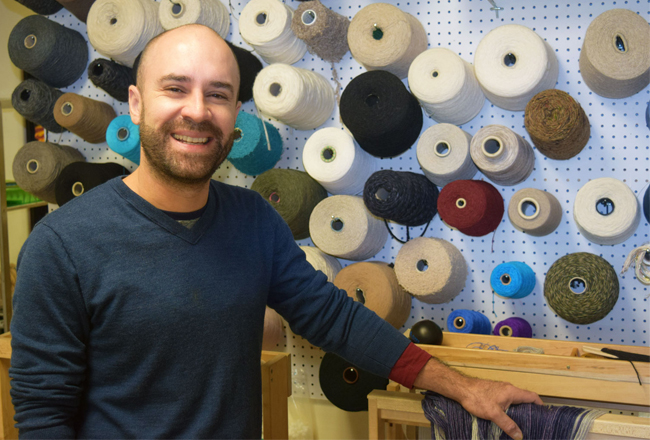
The earliest examples of weaving were found at the Dolnà Věstonice archaeological site in the Czech Republic, where Upper Paleolithic people created twined and plain woven cloth around 27,000 B.C.
More recent examples of weaving can be found in Fairfield County classrooms and gallery workshops conducted by Ruben Marroquin, a Bridgeport-based artist.
According to Marroquin, today”™s youth, which never knew of life without the internet and digital devices, is endlessly fascinated with the possibilities of this excessively old school design process.
“It”™s amazing that we had such a positive reaction,” he explained. “We have about 30 of these looms and they are really easy to use. Even though looms are ancient, they are often referred to as the first computer because it was the first machine that you can program and it does something for you. In that sense, you program a pattern with punch cards or simply by counting the number of strings to create a motif.”
Marroquin became enchanted by weaving as an art student during his studies in Venezuela.
Uninspired by the possibilities of working in painting and sculpture, he was invigorated by a museum exhibit featuring the works of German-Venezuelan artist Gego, who used unlikely materials, including cigarette wrapping papers in her weaved compositions.
“There is a Venezuelan tradition of indigenous weavings,” Marroquin added. “In architecture, you can see straw ceilings all over the country.”
During the last three years, Marroquin has conducted weaving workshops at elementary and middle schools in Bridgeport, Fairfield and Westport. Classes include a mix of materials, ranging from natural yarns and paracords to pipe cleaners. Students work on hand-held looms while Marroquin uses contemporary design theory to help them achieve their creative goals.
“I tell the students to look at it as if they are designing a website or making a painting,” he said. “So, the placement of the corners is going to be determined by what they want to see on the computer screen. I try to refer it back to the modern era, but I think what is important for them is to distance themselves from the computer screens and do something tactile and tangible that you can take home.”
Word-of-mouth praise of Marroquin”™s efforts by his students and positive reaction to his social media photographs of the weaving classes have enabled him to expand to coordinating weaving circles at birthday parties for children. Adults are also getting into the weaving fun, with Marroquin running workshops at his studio in Bridgeport”™s Arcade Mall that enable adults to explore their own artistic talents.
“We have classes that include a glass of wine and weaving, where we make wall hangings,” he said.
Outside of teaching, Marroquin”™s original weaving creations have brought him acclaim from the art world. He conducted a demonstration of weaving and fiber art at New York”™s Metropolitan Museum of Art and his works have been displayed in U.S. and European museums and galleries. The New York Times noted his works in a 2016 exhibit at the Fairfield Museum as “sophisticated, byzantine embroidery.” He acknowledged multiple inspirational sourcing for his recent creations, ranging from traditional Southwestern Indian art to the modern art compositions of Dutch groundbreaker Piet Mondrian, but added the presentation of his artistic vision via weaving has generated amazement from viewers.
“It”™s always interesting,” he said. “The first thing people say, besides how long did it take you to make it, is ”˜I”™ve never seen anything quite like it.”™ ”
Marroquin was recently commissioned by Los Angeles interior designer Kelly Wearstler to create a dozen original weavings for display in her trade expo presentations. At the moment, he is working on new works without specific deadline goals. “This is kind of good, because it allows me to create my own pieces without timelines,” he said.
Looking ahead, Marroquin is considering the expansion of his weaving workshops into college-level settings.





















